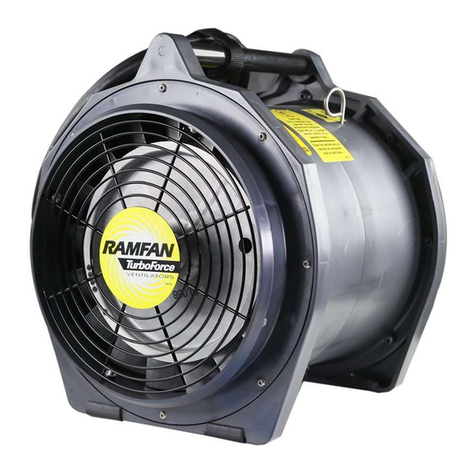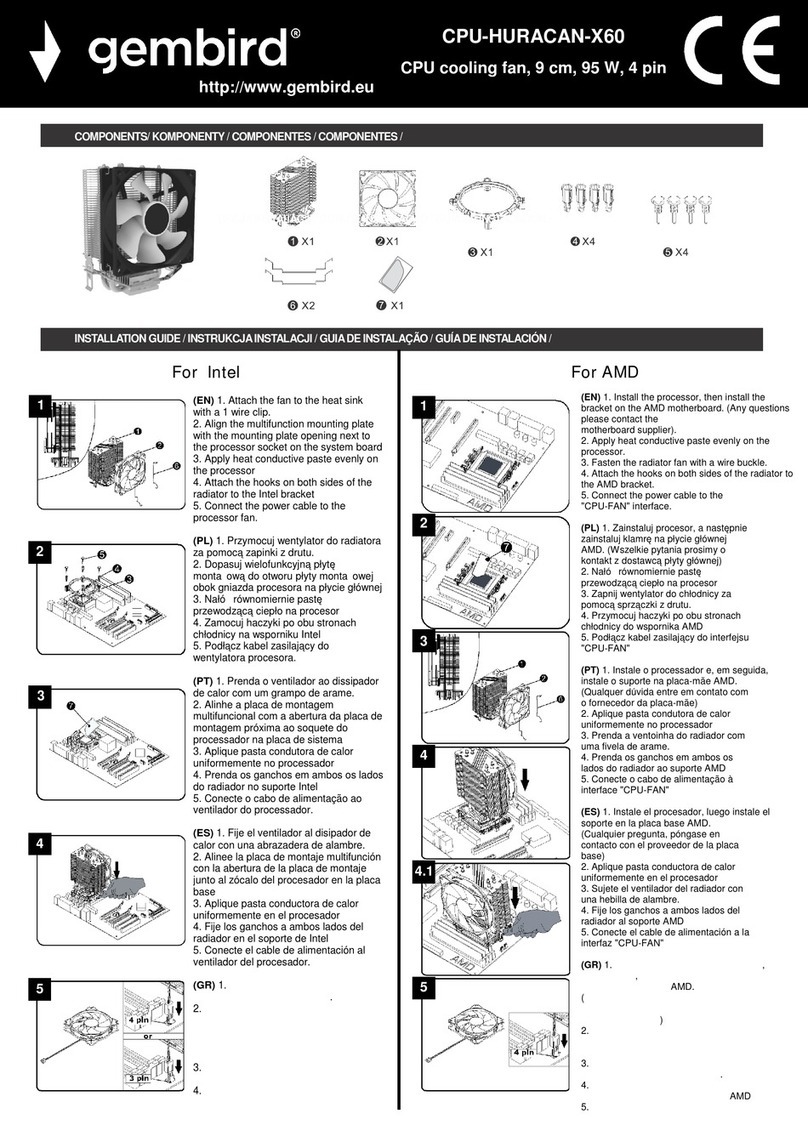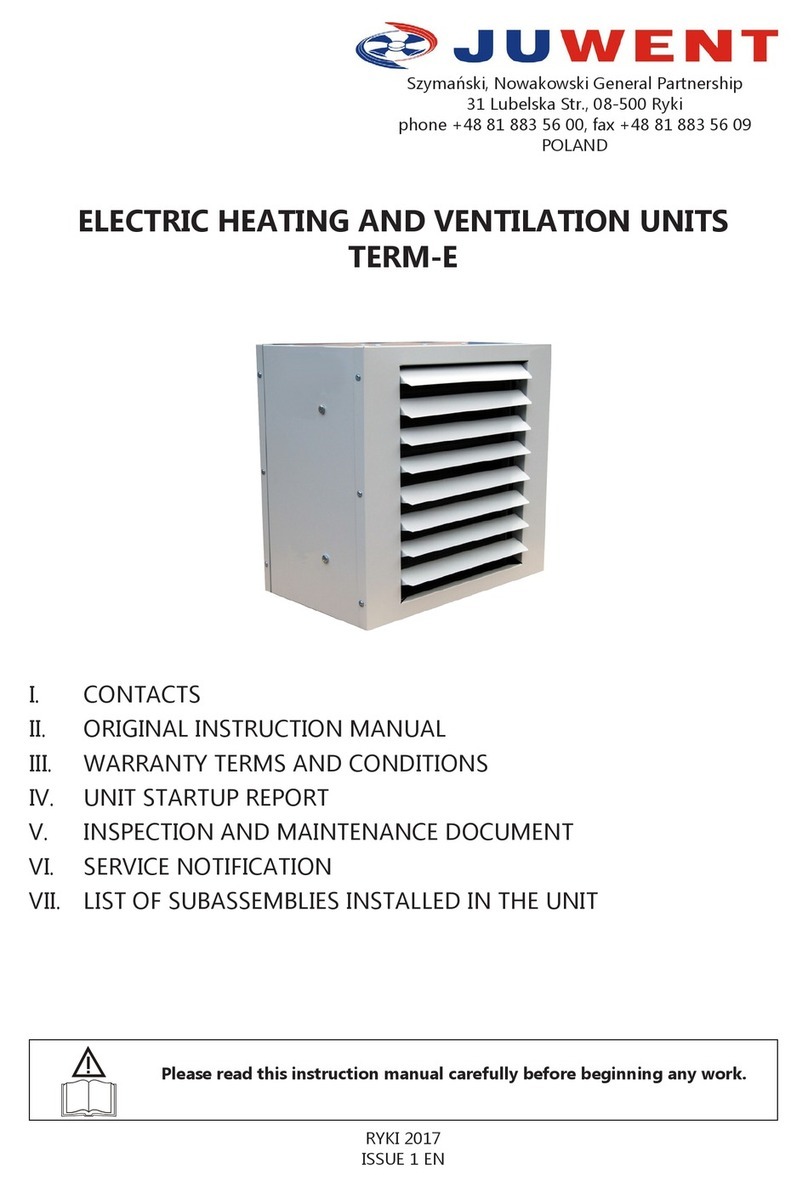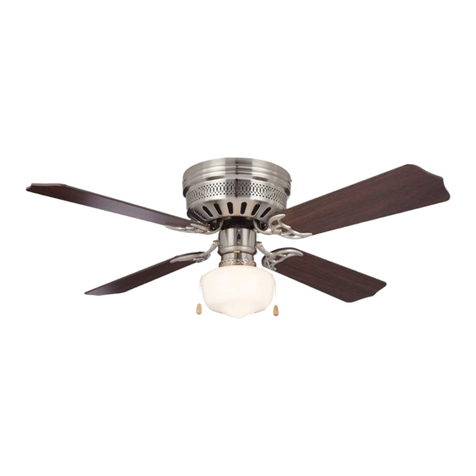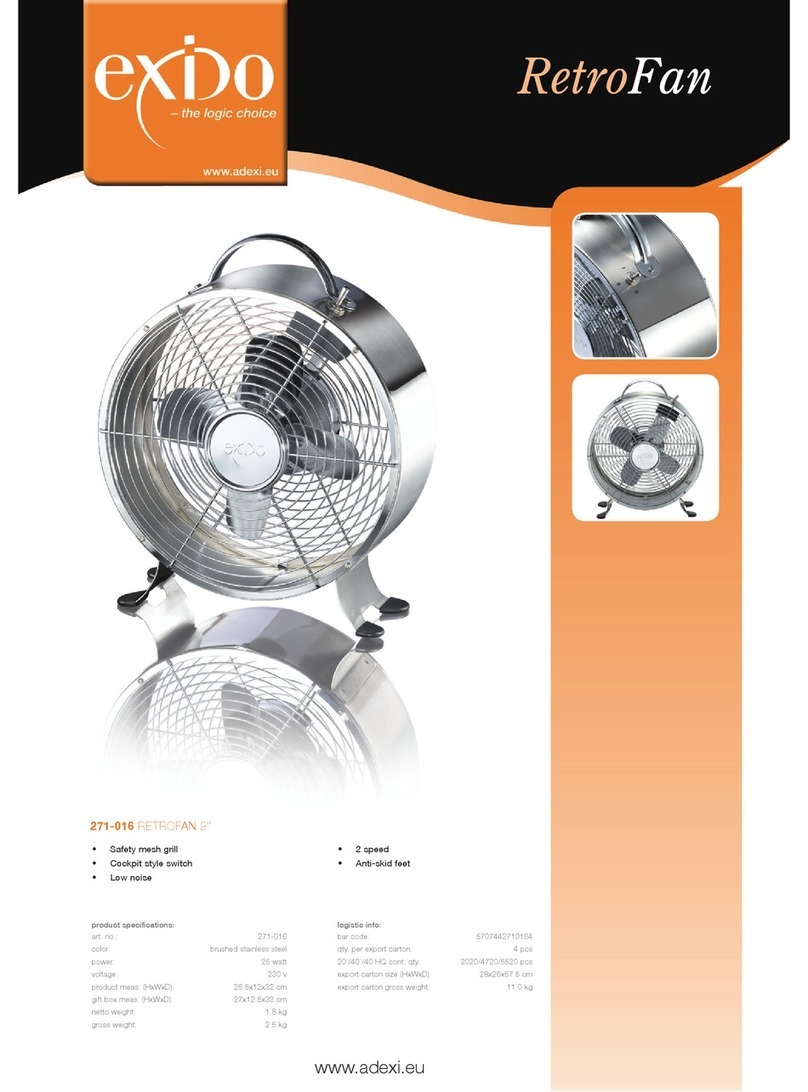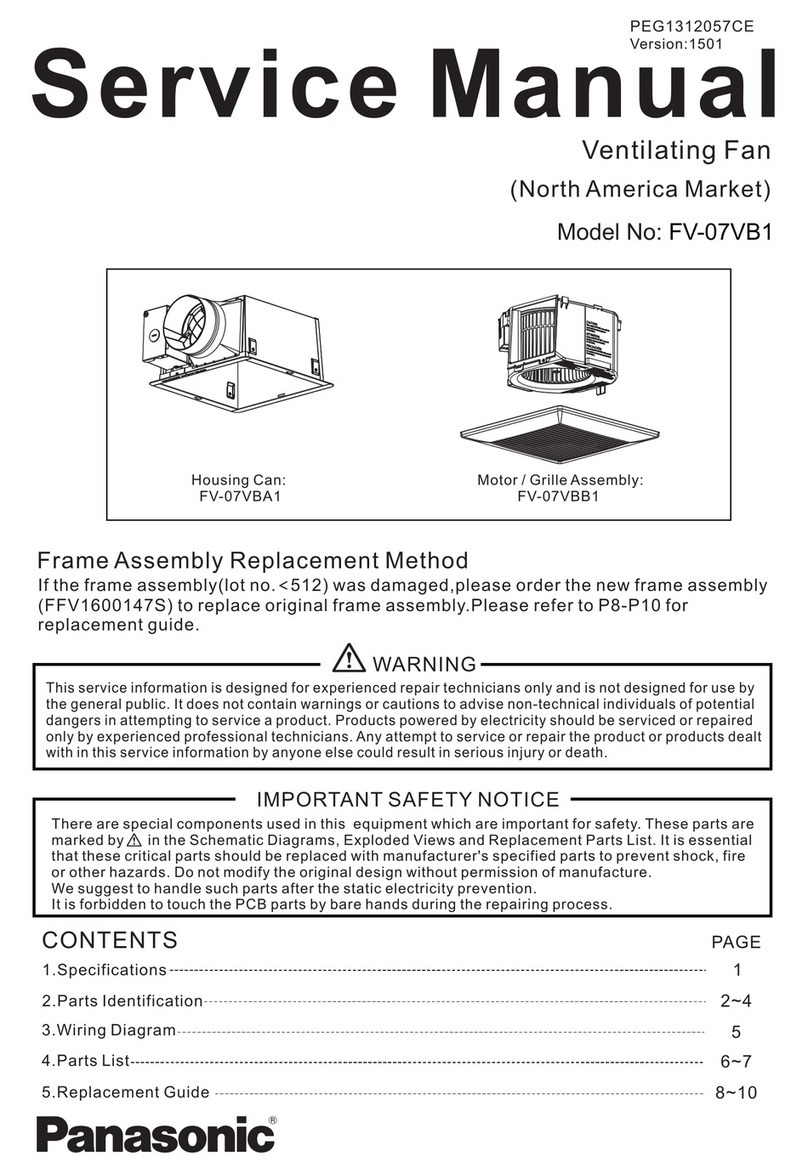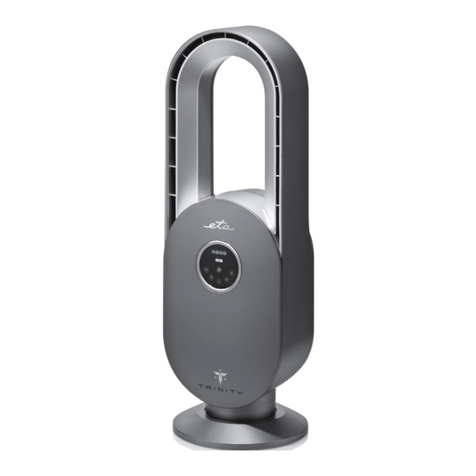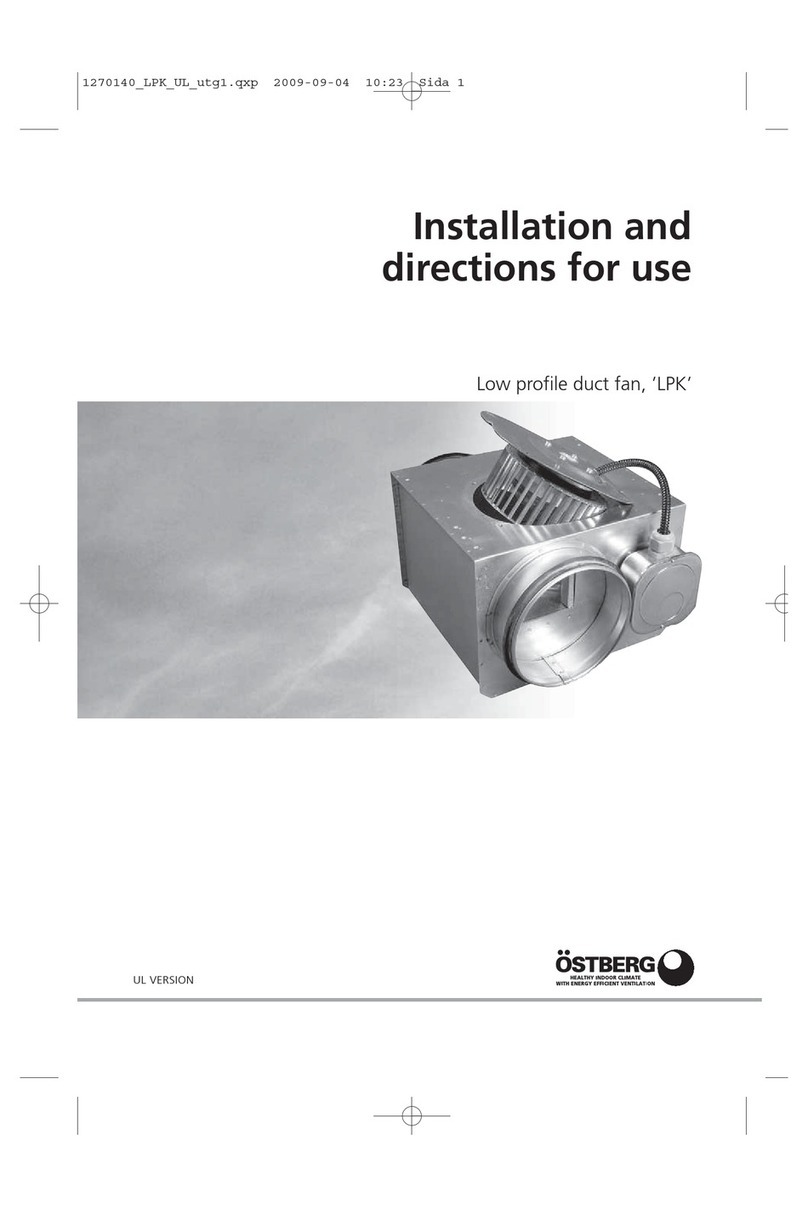Euramco RAFMAN TurboForce WF390 User manual

1
WF390 Owner’s Manual | REV B/0 | Euramco Group
Preface
Thank you for purchasing the RAMFAN WF390 Positive Pressure Ventilator manufactured by Euramco Group.
For more than 30 years Euramco Group has been on the cutting edge of industrial, fire, and marine ventilation
products. Each and every one of our blower/exhausters, smoke ejectors, PPV & LSV fans and accessories
represent the finest technologies available. Every product is constructed to demanding and exact specifications for
quality, performance, and reliability.
When human life depends on having a fan that can deliver clean, safe air, you have only one choice you can trust:
RAMFAN.
Explore our website and online catalog at www.Euramco.com and discover how RAMFAN can make a difference
in the field!
This manual covers operation and maintenance procedures for the RAMFAN WF390 Positive Pressure
Ventilator.
All product information in the publication is based on the most current information available at the time of
printing. Euramco Group reserves the right to make changes at anytime without notice.
READ MANUAL BEFORE STARTING FAN FOR FIRST TIME!

2
WF390 Owner’s Manual | REV B/0 | Euramco Group
Table of Contents
1 | Warning Labels ......................................................................................................................................... 3
2 | Features & Benefits ................................................................................................................................. 4
3 | Safety Precautions.................................................................................................................................... 5
4 | Preparation ................................................................................................................................................ 5
5 | Operation ................................................................................................................................................... 5
5.1 | Control Features ......................................................................................................................... 6
5.2 | Run Procedure............................................................................................................................ 7
5.2.1 | Start Up....................................................................................................................... 7
5.2.2 | Shut Down................................................................................................................... 7
6 | Maintenance .............................................................................................................................................. 7
7 | Storage....................................................................................................................................................... 8
8 | Troubleshooting........................................................................................................................................ 8
9 | Spare Parts ................................................................................................................................................ 8
10 | Supplements............................................................................................................................................ 8
10.1 | Setback Distances .................................................................................................................... 8
10.2 | Shared Operation Zone .......................................................................................................... 10

3
WF390 Owner’s Manual | REV B/0 | Euramco Group
1 | Warning Labels
Ventilator Cautions, Warnings & Specs:
NOTE: This fan is NOT for use in Explosive Atmospheres!

4
WF390 Owner’s Manual | REV B/0 | Euramco Group
2 | Features & Benefits
WF390 | 16”/40 cm
Water-Powered Turboventilator with TurboForce™ Technology
Fan output is only half the story in PPV. RAMFAN fans are more penetrating, high velocity airflow means
faster cooling and clearance of dangerous smoke and toxic gases. TurboForce Technology accelerates the
airflow and literally cuts into the dangerous heat and smoke layer to quickly clear and cool the way for
advancing firefighters.
The NO COMPROMISE Leader
RAMFAN® is the brand leader in quality portable ventilation as a result of Euramco Group’s “No
Compromise” approach to user safety, product design and performance. RAMFAN fans are built using
premium components and tested to meet high standards in performance and safety.
NO COMPROMISE Design and Performance
•TurboForce® Fans accelerate the airflow up to 20% greater than conventional propeller style fans
•7-Blade Polymer TurboForce™ Impeller for increased shatter resistance and enhanced PPV
performance
•Outlet for water recycling (closed circuit) to conserve water supply
•Compact, for easy storage in typical engine compartments
•Wide range tilt adjustment
•Powder coated steel frame
•Full-width retractable handle and heavy-duty wheels for upright, push-pull operation
•4 soft rubber feet - fan will never walk back while performing PPV

5
WF390 Owner’s Manual | REV B/0 | Euramco Group
3 | Safety Precautions
DO NOT START fan if there are any signs of shipping damage, particularly to blade, guards, or
housing. If ANY damage is suspected, STOP and call your dealer immediately.
Use safe lifting practices.
Keep fingers, hair, debris, food or any loose objects away from intake of fan.
Wear eye and ear protection.
Start ONLY if fan is sitting in a stable and upright position.
DO NOT move fan while in operation.
•Keep fan guard securely in place. Do NOT operate with damaged or missing fan guards.
•Keep area clear of rocks and debris.
•Operate the fan on a level surface whenever possible, NOT to exceed 20°.
•Do not stand directly in front of the fan.
•Turn fan OFF if you hear unusual noises.
•Exercise care during deployment and storage to prevent physical damage.
•Allow fan to cool before storing.
•Blower should be operated and repaired by trained personnel ONLY.
4 | Preparation for Use
•Use only with properly tested and certified hose to make inlet and discharge connections.
•Connect inlet hose to proper connection. Observe the inlet labeling.
5 | Operation
•STOP the blower if mechanical noise, vibration, or other abnormal condition occurs. Any noise other than
turbine type pitch is not normal.
•Remove protective end caps from inlet and discharge swivels. Connect the inlet and discharge water
hoses to the fan. Run both hoses to provide as straight a path as possible. MAX PRESSURE IS 250 psi/
1.75MPa
•Visually check for leaks or excessive strain from the hose. Leakage should be controlled if the presence of
water could be detrimental to the surrounding area.
5.1 Control Features

6
WF390 Owner’s Manual | REV B/0 | Euramco Group
Refer to Figure 1 below for location of WF390 controls and features.
Figure 1- WF390
Water Outlet
Water Inlet

7
WF390 Owner’s Manual | REV B/0 | Euramco Group
MAX PRESSURE is 250 psi / 1.75 MPa
Figure 1 –WF390 Control Functions & Features
1
Water Inlet
Connect water supply hose
2
Water Outlet
Connect water discharge hose
3
Push/Pull Handle
Retractable handle for easy maneuvering
4
Tilt Mechanism
Adjust tilt from 0to 20
5
Rubber Feet
Rubber feet and wide footprint reduces vibration, lengthens service life.
6
Semi-Pneumatic Tires
Easily roll over wet grass or mud
5.2 | Run Procedure
5.2.1 | Start-Up
1 Read the Owner's Manual completely before starting fan.
2 Wear both eye and ear protection.
3 Complete checks as indicated in Section 4, Preparation for Use.
4 Position the fan on a level surface at your desired setback distance.
5 Using the Tilt Mechanism, adjust fan to the desired angle.
6 Remove protective end caps from inlet and discharge swivels. Connect the inlet and discharge
water hoses to the fan. Run both hoses to provide as straight a path as possible.
5.2.2 | Shut-Down
1 Secure water supply and disconnect from blower.
2 Disconnect discharge hose and allow blower to drain.
3 Flush internal water passages of unit with clean, fresh water after each use.
4 Allow unit to dry. Using compressed air or a blower can reduce drying time.
5 Install end caps on swivels and recover the tilt to 0before storage.
6 | Maintenance
•There are no user serviceable parts. Contact factory for replacement part applicability.
•NEVER operate fan with damaged or missing finger guards.
•Inspect the fan for loose fasteners at least once every 6 months. Tighten any loose fasteners
immediately. Do NOT overtighten.

8
WF390 Owner’s Manual | REV B/0 | Euramco Group
•Inspect impeller blade for cracks and pitting prior to each use. Never operate fan with a broken impeller.
Contact factory for parts and installation instructions.
•Clean with commercially available biodegradable cleaning solutions. DO NOT use solvents containing
chlorinated hydrocarbons (i.e., MEK, Acetone)
•Check rubber feet on frame for excessive wear or breakage.
•Inspect and clean strainer if necessary. Reinstall strainer and strainer adapter on inlet swivel. Tighten
only enough to prevent leakage. Do NOT overtighten. Excessive force can result in damage to threads.
•Flush internal water passages of unit with fresh water after each use.
•Grounding connection on blower should be maintained tight and free of corrosion.
7 | Storage
•Drain water.
•Make sure all parts of the fan are dry.
•Store in the upright position ONLY.
8 | Troubleshooting
•Fan does not tilt down
- Fan is already at the down limit. Tilt fan up.
•Fan does not tilt up
- Fan is already at the upper limit. Tilt fan down.
•Limited Performance
- Increase water pressure.
- Increase outlet hose diameter.
- Check debris filter on inlet.
9 | Spare Parts
10 | Supplements
10.1 Setback Distances
Setback distance, is the term used to describe how far back from the structure’s ingress point to setup the
ventilator. As any front line responder will tell you, techniques are based on the situation at the scene and
should not be dictated by a manufacturer's design limitations.
RAMFAN
Rubber Feet
Part # FZ-TPRRF6
For other spare parts, contact
theteam@euramcosafety.com
RAMFAN
Inlet Strainer
Part # WA2300
RAMFAN
Inlet Adapter
Part # WB2810
RAMFAN
Outlet Adapter
Part # WA2203

9
WF390 Owner’s Manual | REV B/0 | Euramco Group
Here's a bit of insider information: with certain designs, the fan can produce some amazing airflow
numbers set pretty far back, which is great for marketing big numbers, but when positioned at more
realistic distances (closer in to the entry point) the performance of most ventilators is pretty much the
same, because most countries use standard door sizes in the construction of buildings. All our equipment
is rated at several different door sizes to guide your proper selection and to provide a better understanding
of the ventilators capabilities.
Every structure is different, every fire is dynamic, and every piece of rescue equipment must be ready for
anything. Therefore, the topic of "setback distance" needs to be addressed. The setback distance is simply
a general range of acceptable setback distances, that will provide the desired result of ventilating the
structure.
Sometimes structural entries have large approaches, where the ventilator can be setback farther, at
distances of 4 meters or more.
Sometimes a short approach, with stairs or a turn or in a hallway, confines the useable setback distance to
3 meters or less.
The point is, you don't always know, and in this line of work you have to be prepared for anything.
When selecting any equipment for your brigade, you should already know the typical structure types and
sizes in your response area. A ventilators size and performance should be chosen based upon the
following criteria:
1. What is the average size structure in your response area?
If mixed, for example, between small residential/commercial and a few larger industrial buildings,
several smaller fans may be a more realistic choice than a single giant fan that will take up
valuable space and is difficult to maneuver. Several smaller fans, used together, can produce
very impressive air movements and easily fit within the compact compartments of most modern
fire apparatus.
2. How big are your truck's compartments?
Saving space, and minimizing weight, are increasingly becoming concerns of brigades when
deciding which equipment to choose. Furthermore, budget cuts may force fire brigades to use
their current apparatus, more efficiently. That means, packing as much equipment as possible
into your existing truck. To do this, equipment must be lightweight and as compact as possible,
while still providing the performance needed to get the job done.
3. What do you expect from your ventilator?
While there are certain factors that can affect the airflow performance of a ventilator, considering
the challenging realities faced by first responders, there really are more important things to
consider when selecting equipment than which one has the highest airflow performance in a
controlled test environment.
- Reliability:Which ventilator will keep on working after running the gauntlet on fire scene
operations for the next 3 years or more?
- Durability: Which ventilator is tough enough to start right up after the new rookie drops it
out of the rear compartment?
- Performance: Which ventilator will provide superior performance at every ventilation-
required scene in your response area?
10.2 Shared Operation Zone

10
WF390 Owner’s Manual | REV B/0 | Euramco Group
Every fire and rescue scene has an area in which all responders, their equipment, and their vehicles must
share. How this area is shared and how efficiently it is used and managed will determine the quality of the
response itself. We call this the Shared Operation Zone (SOZ).
When selecting the tools, equipment, and vehicles needed to respond to any situation, the best Fire
Fighting leaders will choose the equipment that allows them to manage their response operations the most
efficiently and effectively as possible.
Euramco Group knows this, and designs special characteristics into each product to ensure the SOZ at
your next response can be used effectively.
Any structure fire has limited ingress/egress
opportunities, as determined by the location of
the fire within the structure, the building design,
and the overall mission.
Often, personnel, along with vehicles,
equipment and hoses must be strategically
located around a single ingress point of the
structure. This obviously places restrictions on
the specifications of everything from the
vehicles, equipment & hoses to personnel and
strategy.
Vehicle placement happens first, as first
responders arrive. This immediately places
further restrictions on potential placement of
equipment. Is your equipment designed to
accommodate these restrictions? Or will you be
wishing your procurement officer paid attention
to what really matters when purchasing
equipment, now that you are facing a life &
death situation?
In an average high-rise response situation, the
SOZ gives the responders less than 500 square
meters of area to place equipment and
personnel in front of the main ingress/ egress
point. Many factors come into play.
•How to lay your hand lines?
•Where to place your main pumper,
command vehicle, and rescue truck?
•Where to stage spare SCBAs?
•Where to place your ventilator to
eliminate smoke in the ingress/egress
route? The stairwell?
Consider this carefully, through smart
equipment selection and proper fire fighter
training, develop equipment specifications and
SOPs that meet the actual challenges that you face every day, and the challenges that you will face
tomorrow. Seek the opinions and guidance of those more experienced than yourself. Make sure you are
ready!
Table of contents
Other Euramco Fan manuals
Popular Fan manuals by other brands

Hunter
Hunter 59245 installation manual
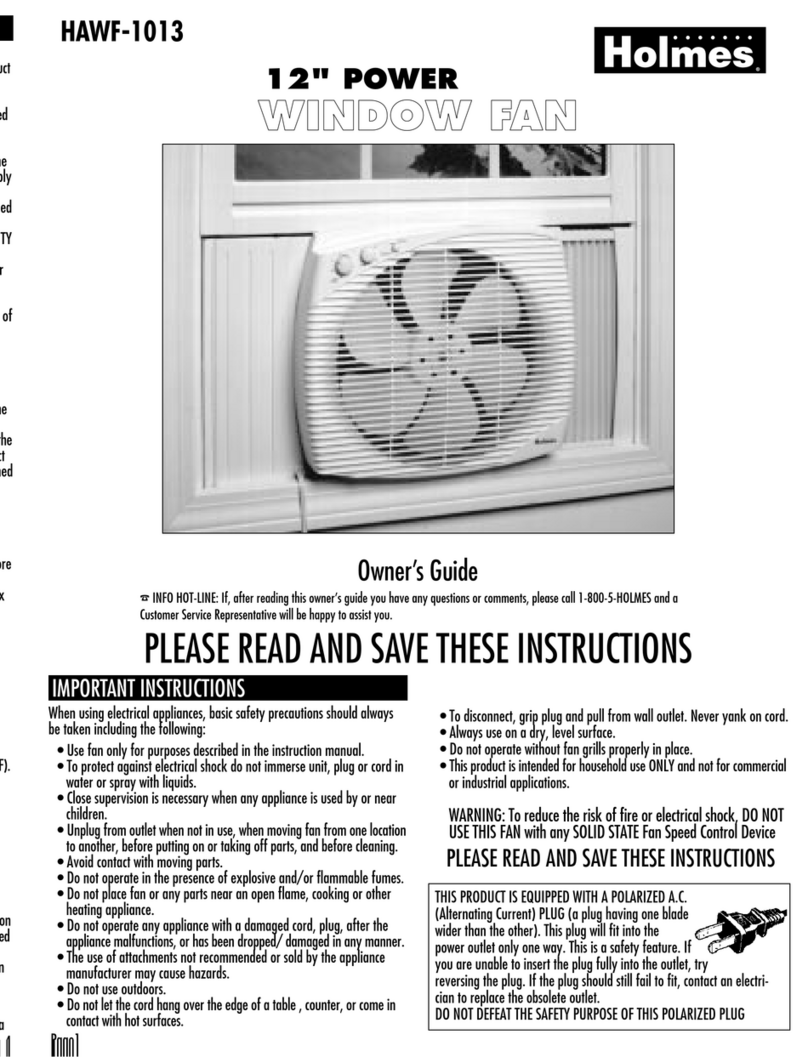
Holmes
Holmes HAWF-1013 owner's guide

Mitsubishi Electric
Mitsubishi Electric EF-35UDT2-GL Installation instructions manual
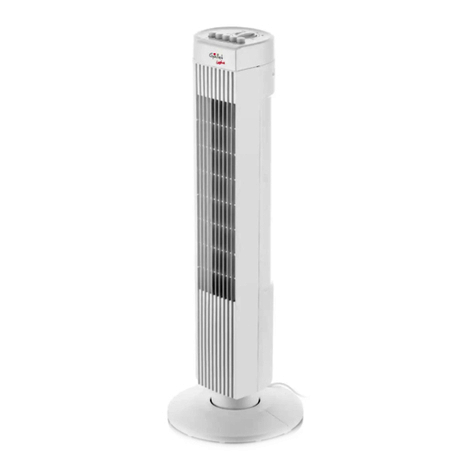
Gallet
Gallet VEN 11T Lestre instruction manual

Progress Lighting
Progress Lighting AirPro P250102 installation manual

Gaggenau
Gaggenau VL 040 714 use and care manual

